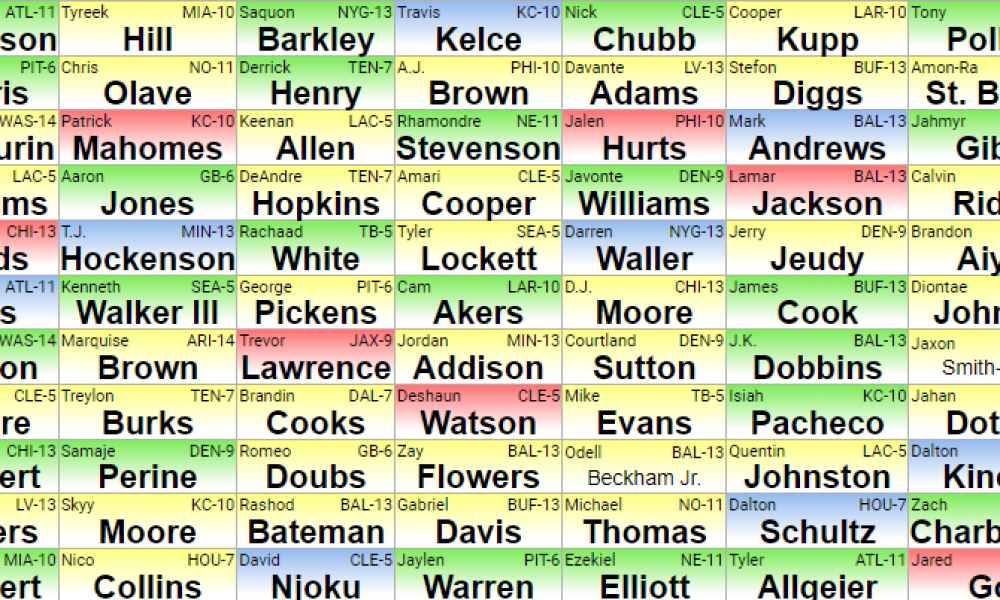Deconstructing the NFL Draft: Which Team Built the Best Roster?
The NFL draft. A crucible of hope, a theater of dreams, and a breeding ground for endless debate. For fans, it’s a weekend of fervent speculation, fueled by mock drafts and whispered rumors. But for NFL franchises, the draft represents the lifeblood of future success, the opportunity to inject young talent into the veins of a roster, propelling them towards gridiron glory.
Identifying the NFL team with the best draft is a complex equation, not simply a matter of tallying Pro Bowlers. It’s a delicate balancing act, weighing immediate impact against long-term potential, factoring in positional value and scheme fit. A single draft can reshape a franchise’s trajectory, transforming a struggling team into a contender, or condemning a hopeful organization to years of mediocrity.
The history of the NFL draft is littered with both triumphs and tragedies. Legendary quarterbacks plucked from obscurity, unheralded rookies blossoming into superstars, and, conversely, highly touted prospects flaming out in spectacular fashion. These stories shape the narrative of the league, reminding us of the inherent gamble that comes with selecting untested talent.
The importance of a successful draft cannot be overstated. In a salary-cap era, hitting on draft picks is essential for sustained success. Rookie contracts provide cost-controlled talent, allowing teams to allocate resources to veteran free agents and build a well-rounded roster. A string of strong drafts can lay the foundation for a dynasty, while a series of misfires can cripple a franchise for years to come.
One key issue surrounding draft evaluation is the element of time. The true impact of a draft class often takes several seasons to fully materialize. A player deemed a “reach” on draft day can develop into a perennial All-Pro, while a “steal” can languish on the bench, their potential unrealized. This delayed gratification makes analyzing draft success a nuanced and often subjective exercise.
Looking at the Baltimore Ravens' 2018 draft exemplifies a well-executed strategy. They selected Lamar Jackson, a quarterback whose unique skillset revolutionized their offense, along with other key contributors like tight end Mark Andrews. This draft significantly impacted their future success.
The Dallas Cowboys’ 1989 draft, featuring Troy Aikman, Emmitt Smith, and Daryl Johnston, is another example of a draft transforming a franchise. This influx of talent propelled the Cowboys to three Super Bowl titles in the 1990s.
A successful draft doesn't just happen. Teams spend countless hours scouting players, analyzing film, and conducting interviews. They must accurately assess talent, project player development, and understand how each prospect fits into their team's overall strategy.
Advantages and Disadvantages of Focusing Heavily on the Draft
| Advantages | Disadvantages |
|---|---|
| Cost-controlled talent | Risk of busts |
| Potential for building a dynasty | Delayed gratification |
| Flexibility in roster construction | Requires strong scouting department |
Best Practices:
1. Thorough Scouting: Invest in a strong scouting department.
2. Prioritize Needs: Address critical roster holes.
3. Consider Scheme Fit: Select players who complement the coaching staff's system.
4. Value over Hype: Avoid reaching for popular players.
5. Prepare for all Scenarios: Have contingency plans for different draft-day outcomes.
Challenges and Solutions:
1. Limited Draft Capital: Solution: Trade down to acquire more picks.
2. Identifying Late-Round Gems: Solution: Extensive film study and pre-draft workouts.
3. Injury Concerns: Solution: Thorough medical evaluations.
4. Character Concerns: Solution: Extensive background checks and interviews.
5. Predicting Player Development: Solution: Analyze past performance and coaching history.
FAQs:
1. What is the NFL Draft? An annual event where NFL teams select eligible college players.
2. How does the draft order work? Determined by the previous season's standings, with the worst team picking first.
3. What is a compensatory pick? Picks awarded to teams that lose more free agents than they sign.
4. What is a draft trade? Teams can exchange draft picks for players or other picks.
5. What is a mock draft? A prediction of how the draft will unfold.
6. What is a draft board? A team's ranking of available players.
7. What is a "sleeper" pick? A player selected later in the draft who outperforms expectations.
8. What is a "bust"? A high draft pick who fails to meet expectations.
Tips for Following the Draft: Utilize online resources, follow draft analysts, and engage in discussions with fellow fans.
The NFL draft is more than just a weekend spectacle; it’s the engine that drives the league forward. Building a successful team requires meticulous planning, astute evaluation, and a touch of luck. While crowning one team with the definitive “best draft” is a subjective and ever-evolving debate, understanding the nuances of draft strategy is essential for appreciating the complex tapestry of team building in the NFL. From the first pick to Mr. Irrelevant, every selection carries the weight of a franchise’s hopes and dreams. By mastering the art of the draft, teams can build a foundation for sustained success and carve their names into NFL history. The quest for the perfect draft is an ongoing journey, a relentless pursuit of the optimal blend of talent, strategy, and foresight. As the NFL landscape continues to shift, the teams that adapt and innovate in their draft approach will be the ones hoisting the Lombardi Trophy in years to come. So, dive into the data, analyze the prospects, and engage in the endless debate – the future of your favorite team may depend on it.
Mastering font size in word a comprehensive guide
The allure of 30 year old actors a captivating era in hollywood
Steve and celina












